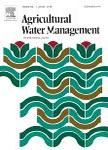版权所有:内蒙古大学图书馆 技术提供:维普资讯• 智图
内蒙古自治区呼和浩特市赛罕区大学西街235号 邮编: 010021

作者机构:Konkuk Univ Dept Civil Environm & Plant Engn 1 Hwayang Dong Seoul 05029 South Korea
出 版 物:《AGRICULTURAL WATER MANAGEMENT》 (农业用水管理)
年 卷 期:2019年第213卷
页 面:580-593页
核心收录:
学科分类:0828[工学-农业工程] 08[工学] 0815[工学-水利工程] 0901[农学-作物学]
主 题:COMS MODIS NDVI Multiple linear regression model Spatial distribution of soil moisture Remote sensing
摘 要:This study attempts to estimate the spatial distribution of the soil moisture (SM) in South Korea (99,260 km(2)) from January 2013 to May 2015 using a multiple linear regression (MLR) model with data from the Korean multipurpose geostationary Communication, Ocean and Meteorological Satellite (COMS), and land surface temperature (LST) data. The normalized distribution vegetation index (NDVI) from the moderate-resolution imaging spectroradiometer (MODIS) on board the Terra satellite was used to reflect the vegetation variations. Observed precipitation data measured by automatic weather stations (AWSs) operated by the Korea Meteorological Administration (KMA) were collected, and SM data were collected from 38 stations operated by various institutions. The regression coefficients of the MLR model were estimated seasonally considering five days of preceding precipitation. The p-values of all regression coefficients were below 0.05, and all coefficients of determination (R-2) ranged from 0.17 to 0.63. Specifically, the R-2 of loam in the summer was the highest at 0.63, and most of the R-2 values were 0.4 or higher. The results of the SM regression showed that the overall R-2 was higher than 0.4 and that the root mean square error (RMSE) was less than 5% at all but a few stations. A time series analysis of the simulated SM revealed that the observed SM data ranged from 0 to 20% for sand, 10 to 30% for loam, 20 to 40% for clay and 30 to 50% for silt. The simulated SM followed the volatility of the observed data in most of the soils. The spatial distribution of the simulated SM showed the same trends with the observed data on the monthly spatial precipitation map. Consequently, the estimated map of the soil moisture index (SMI) can be used to better understand the severity of drought and the variability in the SM.